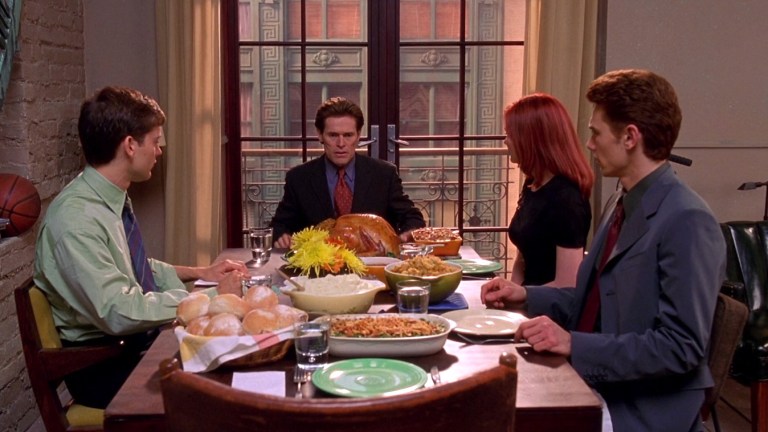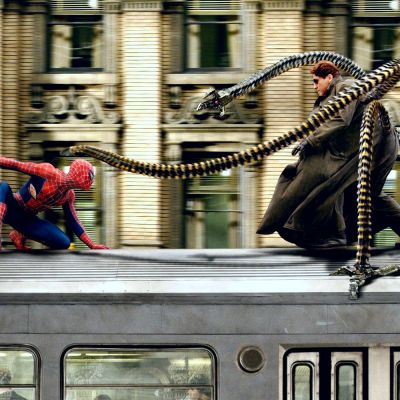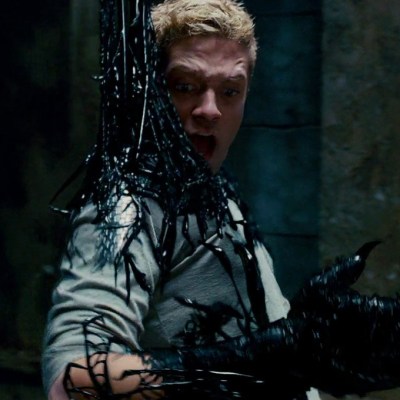Sam Raimi’s Spider-Man Is a Perfect Thanksgiving Movie
Sam Raimi and Tobey Maguire’s original Spider-Man is remembered as one of the great summer movies, but it really should be part of your Thanksgiving tradition.

Thanksgiving is an interesting holiday when it comes to cinema. Despite being among the most widely celebrated and popular seasonal gatherings (at least in the U.S.) where the only prerequisite is the sweatpants you’ll need after dinner, there have been few genuinely great movies set around Turkey Day. John Hughes’ Planes, Trains and Automobiles is of course an indisputable classic; and the beginning of Miracle on 34th Street also kicks off at the Macy’s Thanksgiving Day Parade (before quickly transitioning into Christmas movie iconography). But where are the modern classics?
Well if you count organic webbing as a good substitute for stuffing, and don’t mind a pumpkin bomb baked into your pie, then you probably have overlooked one of the all-time great Thanksgiving flicks: Sam Raimi’s Spider-Man from 2002. Yes, the superhero movie which spans about a year and is probably best remembered for an upside down kiss in the rain is also a Thanksgiving miracle.
Spider-Man is of course one of the most important entries in its genre. Released in 2002 at the beginning of the millennium and notably less than a year after the Sept. 11, 2001 attacks, the movie came out at a moment when audiences were desperate for escapism and clear cut good versus evil morality. So entered Raimi’s modern reinvention of the superhero movie formula and its embrace of color, humor, and grandiose comic book storytelling—all elements which had vanished from multiplexes after Batman & Robin five years earlier. Yes, Blade and X-Men came out in the interim, but both of those movies ran from their comic book roots, with the former hiding it was inspired by a Marvel character and the latter downplaying it with black leather costumes and maximum amounts of brooding.
But Spider-Man? It begins with Tobey Maguire’s Peter Parker basically going “aw shucks” while staring at the redheaded girl next door, Kirsten Dunst’s Mary Jane Watson, and culminates with him catching her after a guy dressed like a four leaf clover throws her from the Queensboro Bridge. It was a major step in paving the way for both the Marvel Cinematic Universe’s nerdiness and even arguably Christopher Nolan’s gritty reboot of Batman a few years later, which like Spider-Man would be an A-budgeted superhero movie that actually cared about pesky things like character arcs and motivations.
Indeed, for as much as we can look back nostalgically on the bold colors and sunny disposition of Spider-Man and its two sequels, Raimi also (perhaps better than any filmmaker since) zeroed in on Spider-Man comics’ ultimately melodramatic core. Artist John Romita Sr. once mused Spider-Man comics are soap operas where a fight breaks out every once in a while, and what can be more soapy than Thanksgiving dinner?
A Date on Thanksgiving
Ever since David Koepp turned in his first draft for the Spider-Man screenplay, the plan was to center the second and third acts of a Spider-Man movie around the Thanksgiving holiday. In Koepp’s earlier versions, in fact, both the Green Goblin and Doctor Octopus characters battle the web-head at the famed Macy’s Day Parade, complete with snow and the inclement weather we tend to associate with it.
It is not clear when or why the Macy’s Day Parade was changed into the World Unity Festival in the film—other than perhaps legal necessities which made a nondescript Times Square celebration cheaper to create than Macy’s patented parade—but it still serves the same narrative function. A major Midtown event has caused all the characters to gather around an NYC landmark covered in decorations and giant balloons—which prove perfect trampolines for Maguire’s Spidey and Willem Dafoe’s Green Goblin to bounce from.
Additionally, the film even includes a musical number from Macy Gray, raising the question if one enterprising Sony executive really thought “Macy Gray” was close enough to “Macy’s department store?” No matter the reason the parade might have had its name changed, there is still Thanksgiving itself—a brand which can never be copyrighted. Hence one of the best scenes in the movie where a few days later, all the major surviving characters gather for Thanksgiving dinner: Peter Parker, Mary Jane, Aunt May (Rosemary Harris), Norman Osborn, and his son Harry (James Franco).
In the film, the scene occurs directly after Spider-Man and the Green Goblin’s second duel, this time in a burning building where the wall-crawler had his arm slashed by a flying buzzsaw. As a consequence, Peter is bleeding deeply from the arm when he arrives at his apartment late, and with the entire cast of supporting characters gathered in the room below.
There’s a moment of tension where it seems like Norman—who Peter is unaware is the Goblin—is about to figure out his son’s best friend is an enemy, but Spidey’s quick evasion of Norman’s suspicions turn out to be moot. The dinner they’re attending will soon make feast enough out of its characters’ secret identities.
Conflicting Family Values
Amusingly, both Peter and Norman show up to Thanksgiving dinner wearing the colors of their masked arch-nemesis. Peter arrives in a green shirt with a muted purple tie while Norman comes wearing a blue dress shirt and red tie. Clearly, both are thinking about their foe. But even if the colors are reversed, the values are not.
At the end of the day, the universal appeal of Thanksgiving is about hearth and kin, with friends and family coming together and sharing a special meal while counting their blessings. However, the values of the Parker/Osborn gathering is what creates delicious tension, even before anyone has carved the turkey.
While the focus of the scene is on Peter and Norman, the quiet contrast between Peter and his pal Harry makes for a subtler and more striking juxtaposition. Each has been raised in the deep shadow of a father figure: for Peter it is his missing Uncle Ben (played by the late great Cliff Robertson earlier in the movie), and for Harry it’s obviously his highly successful industrialist papa. This Thanksgiving scene marks the first major holiday Peter and Aunt May are having since their beloved Ben Parker was murdered by a carjacker earlier in the movie. The fact they hold it at Peter and Harry’s swanky Soho loft—which Norman is paying the rent for—as opposed to May’s Forest Hills home is interesting.
Aunt May says this is the boys’ “first Thanksgiving in this apartment” but it’s also the first without Ben. His absence goes unmentioned, but his presence is instilled in Peter’s sense of virtue and responsibility—hence fighting the Green Goblin earlier that day! Meanwhile Harry is trying to be the man he thinks his father would want to see. He invites Dad to his apartment to meet Mary Jane Watson, the girlfriend he’d up until this day hidden from both Norman and Peter.
But for Harry, MJ is little more than a prize; a trophy he can show off to his father, just as presumably his father did with his mother. It doesn’t work. Once Norman notices the bloody wound on Peter’s arm (the same wound that Spider-Man incurred earlier that day), his mind is completely consumed with vengeance: vengeance on the masked do-gooder who denied him, and vengeance on the boy he believes has betrayed his generosity.
So when Norman gets up to leave, he dismisses Harry’s hurt feelings by mocking MJ within earshot of the girl and everyone else at dinner. “Harry, please, look at her. You think a woman like that is sniffing around because she likes your personality? Your mother was beautiful too, they’re all beautiful until they’re snarling after your trust fund like a pack of ravening wolves.”
It’s a nasty comment and perhaps one more explicit than normal from Norman, whose voice begins curling into the Goblin’s when he adds, “A word to the not-so-wise about your little girlfriend. Do what you need to with her then broom her fast.” However, it represents the type of lessons Norman clearly has always imparted to Harry, implicitly or otherwise. Harry doesn’t stand up for MJ to Norman, and when he comes back in and sees MJ heard all the awful remarks and has resolved to leave, he doesn’t try to comfort her. Instead he defends his father’s boorish behavior. He even talks to MJ in a way one might assume he heard Norman speak to his mother.
“That ‘creep’ is my father,” Harry whines. “If I’m lucky I’ll become half of what he is, so just keep your mouth shut about stuff you don’t understand!”
And like that Thanksgiving dinner is officially ruined. Norman’s recent villainy led him to exit the table, but it’s his presumably lifelong chauvinism and cynicism, and how the sins of the father have been passed down, which drives MJ away and leaves even Aunt May aghast at Harry’s demeanor.
Holiday Blues
All of which gets to the strength of Spider-Man and its value as an unlikely Thanksgiving movie. While the scenes explicitly set on the holiday are brief, they underscore an all-too-common problem for families around the world during holidays: the clash of personalities and values with extended family. Every character in Spider-Man should be friends on balance. Peter is Harry’s good friend who shares Norman’s passion for science; MJ grew up next to Peter and has been neighborly with him and his aunt and uncle her whole life; and Aunt May of course cares for her nephew’s friends.
And yet, these folks can’t even sit down to dinner for an hour without tempers flaring and voices raising. Peter is very much his uncle’s proverbial son, a kid who is always trying to do the right thing as defined by a very traditional set of family values. Harry is trying to emulate his father’s morality, but that morality comes from a place of misanthropy and self-interest, where every person is a tool or a threat that must be assessed and exploited. During this particular moment, Norman realizes Peter is the latter.
In this way, Spider-Man is a bit like the recent faux-Thanksgiving movie, Knives Out. It’s awash in autumnal colors and often cozy-looking clothes, but it’s about a family (or chosen family) of people who don’t particularly like each other. And sure enough, one of them is going to try and murder another before the end credits.
Which makes it good therapy for those who dread Thanksgiving, and pretty enjoyable for those of us who don’t. Either way, it has a glowing, timeless sheen which captures New York City in a moment of transition between the 20th and 21st centuries, yet feels happily removed from both. In this NYC, older millennials still show up to Thanksgiving in suits and ties, everyone wears a trench coat, and only the rich kid has a cellphone. It feels simultaneously modern and retro, and as perennial as holiday gatherings themselves.
So this Thanksgiving if you’re looking to watch a movie set on the big day but made in the last 20 years, you can do worse than Spider-Man!


